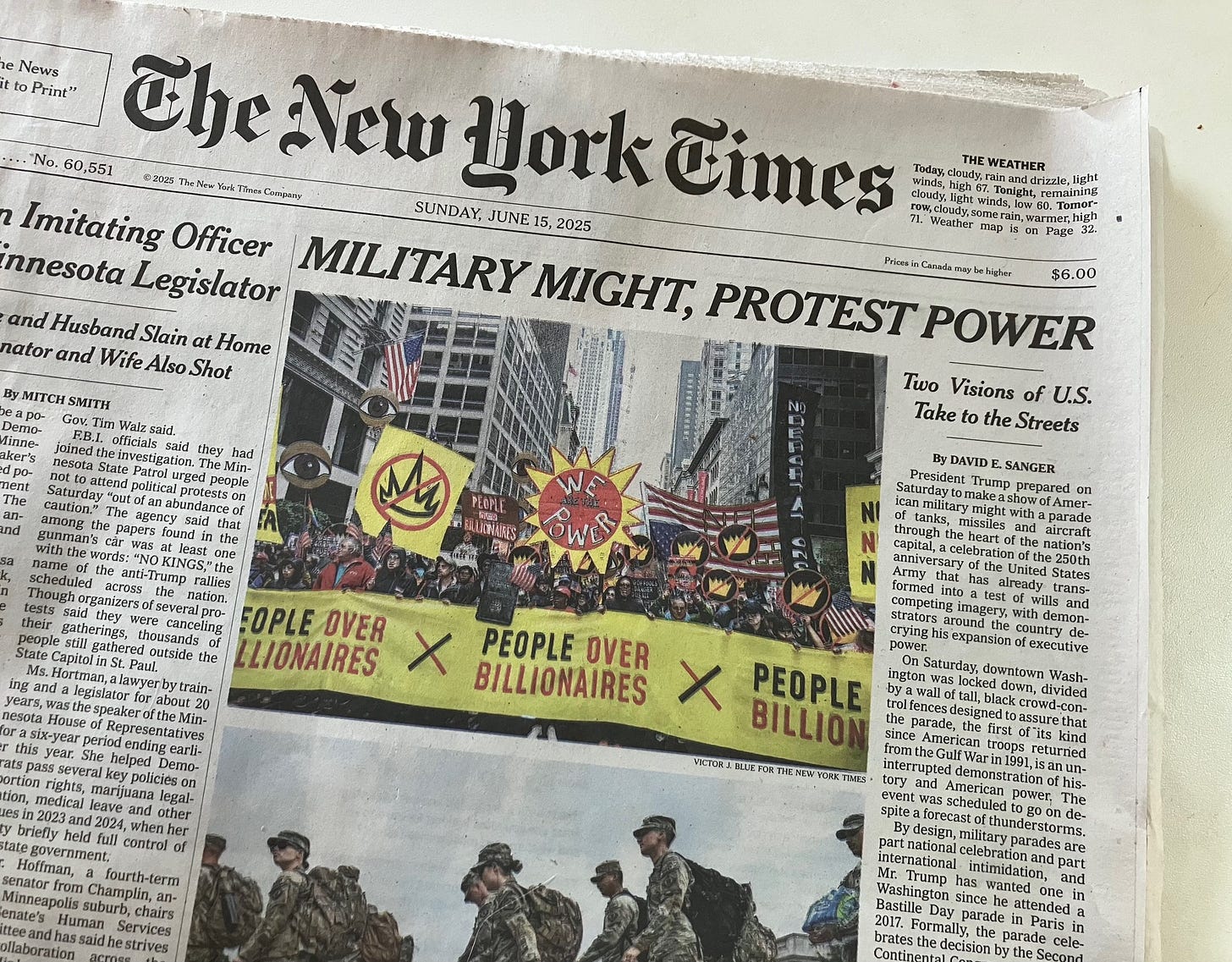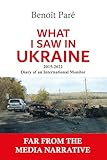
All those who have been wondering when mass resistance to Trump 2.0 would materialize need wait no longer. It is here. It is happening. It is now.
In truth, the new wave of defiance has been swelling for some time.
Following last November’s presidential election, media outlets such as the New York Times steadily pushed a story of progressive demobilization. The narrative went something like this: back in 2016, Trump opponents were fired up and ready to fight back, but this time around, in 2024, those who voted against his return were merely dispirited and resigned, hardly in the mood to take to the streets again. Oftentimes, commentators piled on by expressing skepticism about whether protesting was even worth it to begin with.
This story was flawed from the start.
Sure, in the immediate aftermath of the election, progressives took time to grieve Trump’s return. But already in November, mass organizing calls led by groups including the Working Families Party were drawing upwards 50,000 participants. (I don’t know about you, but for me anything over 10,000 people counts as being larger than my typical Zoom session.)
Within a week after Trump’s inauguration, protests were fomenting in earnest. We saw rallies outside of federal buildings and weekly boycott vigils at Tesla dealerships. Soon, there were calls for nationwide days of action, first taking the form of the 50501 protests in February. Then, on April 5, the Hand’s Off rallies took place at locations across the 50 states.
Erica Chenoweth and Jeremy Pressman, leaders of an effort called the Crowd Counting Consortium, reported in March that “our research shows that street protests today are far more numerous and frequent than skeptics might suggest.” They also noted that in February “we’ve seen more than twice as many street protests than took place during the same period eight years ago.” Last week, they released an updated tally, stating that “protest has been surging” since then and that “Overall, 2017’s numbers pale in comparison to the scale and scope of mobilization in 2025 — a fact often unnoticed in the public discourse about the response to Trump’s actions.”

All of this came before the events of the past two weeks, which further augmented the size and scale of anti-Trump mobilization. First came large demonstrations in Los Angeles against ICE immigration raids and the deployment of the National Guard. (Manuel Pastor has a very nice report from the frontlines of the protests over at Dissent.) Then came the No Kings actions last Saturday, which were massive and took place at as many as 2,000 locations, organizers told NPR. Data journalist G. Elliot Morris, formerly of FiveThirtyEight, estimated the total number of participants at No Kings events between 4 and 6 million.
These are historic numbers.
By way of comparison, gigantic protests against the Iraq War on February 15, 2003 drew possibly 3 million demonstrators in the U.S. (along with between 12 and 30 million worldwide). The Crowd Counting Consortium estimated that the original Women’s March on January 21, 2017, acknowledged as a gargantuan mobilization, attracted between 3.3 million and 5.6 million protestors. In another historic deployment, Black Lives Matter protests may have drawn many millions more in 2020, but with the caveat that actions were spread out over multiple weeks.
In terms of single-day events, No Kings may not have reached the heights of the first Earth Day celebration, in 1970, which is sometimes cited as the largest day of action in U.S. history, but it’s up there with all the big ones.
Our team witnessed strong turnout in Philadelphia (around 80,000) and in New York City (upwards of 100,000). Organizers reported crowds of as many as 500,000 in Boston, 70,000 in Seattle, 200,000 in Los Angeles, and 100,000 in Chicago, among gatherings in other major cities. On his Facebook page, organizer Chris Crass did a wonderful job of compiling photos of No Kings protests from around the country. The images are inspiring: People swarming intersections in Evanston, Illinois, braving the rain in Little Rock, Arkansas, filling Liberty Plaza outside the state capitol in Atlanta, Georgia, and lining roads in Indianapolis, Indiana and Gainesville, Florida. All this stood in stark contrast to Trump’s gloomy, expensive, and under-attended military parade the same weekend.
Now, if you will allow a digression, there are a variety of quirks to consider when talking about the size of any mobilization. Crowd-counting numbers can be notoriously flexible and politicized. In Armies of the Night, his Pulitzer Prize winning “history as a novel” narrating a fall 1967 March on the Pentagon, author Norman Mailer jokingly suggested a rule of thumb for triangulating protest attendance: “[T]he police estimate multiplied by four might be as close to the real number as the Left Wing estimate divided by two and a half,” he wrote. “Thus a real crowd of 200,000 people would be described as 50,000 by police and a half million by the sponsors.”
Even when the numbers are reliable, comparisons between protests are not always apples to apples. For at least five decades after the 1963 March on Washington, the dominant model for a national day of action was to try to get everyone to a single location, often Washington, DC. Success was measured by how many people you could rally in that one spot. In some instances, such as the 2003 Iraq war protests, there might be one leading location on the West Coast (say, San Francisco) and another in the East (New York City), but the general model held. If the protest was to be a success, organizers needed to spend a lot of time thinking about filling buses and transporting people significant distances to join in a collective mass gathering.
By the time of the Women’s March in 2017, this dominant model was being replaced with something different. There was indeed a large central event in Washington, DC for the Women’s March. But there were also sizable events in other big cities such as New York City and Philadelphia, and even gatherings in smaller cities like Harrisburg and many points in between. Previously, the going wisdom had been that sending people by bus to the main event would be mutually exclusive with getting decent turnout locally. But that was not the case for the Women’s March. The big numbers in DC did not really seem to eat into crowds in smaller cities. Success was no longer measured by the numbers of people who showed up in one location, but how many events across the country could be hosted and what the cumulative attendance might be.
As it turns out, having protests everywhere is conducive to participation. Regarding last weekend’s No Kings demonstrations, famed Rabbi Arthur Waskow wrote about attending a modest event in the Germantown neighborhood of Philadelphia:
“Why did my beloved life-partner… and I choose to join about 200 people at the Lovett Library to say ‘No Kings!’ Instead of 80,000 demonstrators downtown where they swallowed up and liberated whole neighborhoods? Because I am 91 years old and my life partner is 82. We were sure that the massive downtown crowd, impressive as it was for demanding change, would make it impossible for the two of us to navigate. The library was one of countless small gatherings across the country and in big and even middle size cities the turnout was enormous.”
Lowering the bar for participation is undoubtedly positive in this respect. Of course, there are trade-offs. Because it’s easier to show up to your local town square than it is to spend a day or a weekend bussing back and forth to DC, participants are investing less time in the collective experience of traveling and assembling with others, things that can be good for cultivating further commitment. And, as I have written elsewhere with my brother Paul, the success of civil resistance often involves demonstrating the hardship voluntarily taken on movement participants—meaning that actions which require people to make higher levels of sacrifice can have their own benefits.
All this is to say that the size of any given crowd is not the only thing that matters.
In some ways, a variety of the smaller No Kings gatherings may have been more politically significant than the largest metropolitan ones. A friend of mine estimated that upwards of 5000 people turned out in his South Jersey town of Collingswood, a huge number for that area—arguably more impressive as drawing twenty times as many in nearby Philadelphia. Another organizer friend went to a protest in a small Pennsylvania town about an hour outside of Philly’s blue bubble. There, she reported, between 500 to 700 people lined a major roadway for a long stretch, encouraging passing drivers to sound their car horns in support. The steady, if intermittent, stream of honks gave courage to neighbors whose town borders a county that went solidly for Trump in 2024.
In Jacobin, Branco Marcetic argued that the presence of events deep into MAGA country signals a notable shifting of political energies. “[There is an] important point to be made here,” he wrote:
“The turnout in liberal cities and even in Trump-voting towns and counties doesn’t necessarily mean that anti-Trump voters outnumber the president’s supporters in these areas or their states—in many cases, they don’t. But it does suggest that voters opposed to Trump’s agenda—who across the country were met with few to no counterprotesters, even in deep red parts of the country—are vastly more energized than his supporters, and that despite his having won the popular vote…that Trump’s public support is a lot softer and more passive than his 2024 victory made it seem.”
In an article a couple of months ago, Paul and I outlined the key characteristics that define “moments of the whirlwind”—or periods of intensified social movement upsurge. It is clear that the current moment exhibits these qualities: Demonstrations are sparked by highly publicized “trigger events” (think ICE raids at Home Depot or a U.S. Senator in handcuffs), and participation is decentralized, not driven through pre-established organizational structures. The No Kings events of last weekend were led or sponsored by groups including Indivisible, the American Federation of Teachers, and the ACLU. All of the 200 organizations that signed on for the protests, especially the more established ones, deserve credit for refusing to bow to the authoritarian impulses of the Trump administration—especially when we have seen some leading law firms, media organizations, and universities fail to muster such bravery. Nevertheless, recruitment of the millions of people to the protests did not come through organizational phone trees or people’s individual relationships with organizers, but through momentum driven by widespread outrage at Trump’s actions.
Wired magazine published an article this week contending that defiance this time around, aided by new technologies, is far more decentralized than the Women’s March in 2017 and other resistance in Trump’s first term. The article reflects the magazine’s techno-fetishism, and its argument is a bit comical, given that the Women’s March itself was no august and long-standing institution but rather an ad hoc formation that swiftly coalesced in the whirlwind following Trump’s first election. Nevertheless, the article showed how abundant dissident energy is bubbling up in countless places and often has yet to be absorbed by formal organizations.
The article also pointed to a third common trait of whirlwinds: In addition to drawing in new participants from unexpected quarters, these moments spur a wealth of activity among these newcomers that is not dictated by any centralized command. As Wired reported, “the Tesla Takedown protests began with a single Bluesky post that exploded in large part thanks to social media posts, including protesters’ pictures and videos outside dealerships.” (Even Elon Musk himself ultimately acknowledged the success of demonstrations in shrinking Tesla’s earnings, although he blamed the impact on “paid protesters.”)
Or, as another example, the magazine profiled a couple in the Deep South that got involved by creating a website that allows people to order free stickers that they can post in high-traffic areas in their neighborhoods. The stickers display a QR code that directs users to resources about the warning signs of fascism: “What began with 500 stickers posted all over their small town,” reporter David Gilbert wrote, “quickly grew—with the help of an appeal on Reddit—to a campaign that has so far seen the couple and their children send 750,000 stickers to more than 1,000 people in all 50 states.”
All this raises the question: What should we do now that the whirlwind has arrived?
Paul and I hope to write on this in more depth, but there are many things that can be noted at least in passing: First, people should contribute however they can, and they should work to convince organizations that they are a part of to join in as well. Many established groups are still hesitant to throw down, yet the addition of their credibility and resources can make an important difference. It is hardly too late to get started: The most sweeping whirlwinds form not when a single trigger event gives rise to protest, but when a succession of triggers result in a series of escalating civil resistance. Along these lines, we can be sure that Trump will present more provocations, giving more opportunities for creative responses.
Protests are polarizing, meaning that they make people who might otherwise have been undecided or inattentive choose a side. Movements should focus on maximizing positive polarization and minimizing the negative. As we have previously argued, this means being smart in framing the demands of an action, highlighting sympathetic protagonists and unsympathetic oppressors, and heightening the contrast between the inventiveness and determination of resistance and the repressive violence of the state.
Trump is unpopular. There is clear evidence—from public opinion polling to pushback on the streets—that he is wildly overreaching his mandate. It is important to remember that Trump’s 2024 election victory was a narrow one: he carried 49.8% of the popular vote, as opposed to 48.3% for Kamala Harris (and even his electoral college win was nowhere close to the commanding totals amassed by Ronald Reagan in 1984, Richard Nixon in 1972, or LBJ in 1964). Since November, Trump’s popularity has tanked, even on issues where he once enjoyed an edge, such as the economy and immigration. The rank cruelty of his ICE raids is becoming increasingly clear, and Republicans have touched a third rail of American politics by slashing programs like Medicare.
Civil resistance plays an important role in solidifying this unpopularity and—as Trump perpetually lies about the impact of his policies—in educating the public about what is really going on. It helps to generate momentum for backlash at the polls, not just in the midterms or the next presidential elections, but in a plethora of state and local contests already taking place. And, in the interim, mass demonstrations encourage noncooperation at many levels that make the implementation of the White House agenda more difficult.
In short, popular resistance boosts the costs of overreach. Let us hope that we can watch the defiance grow.










